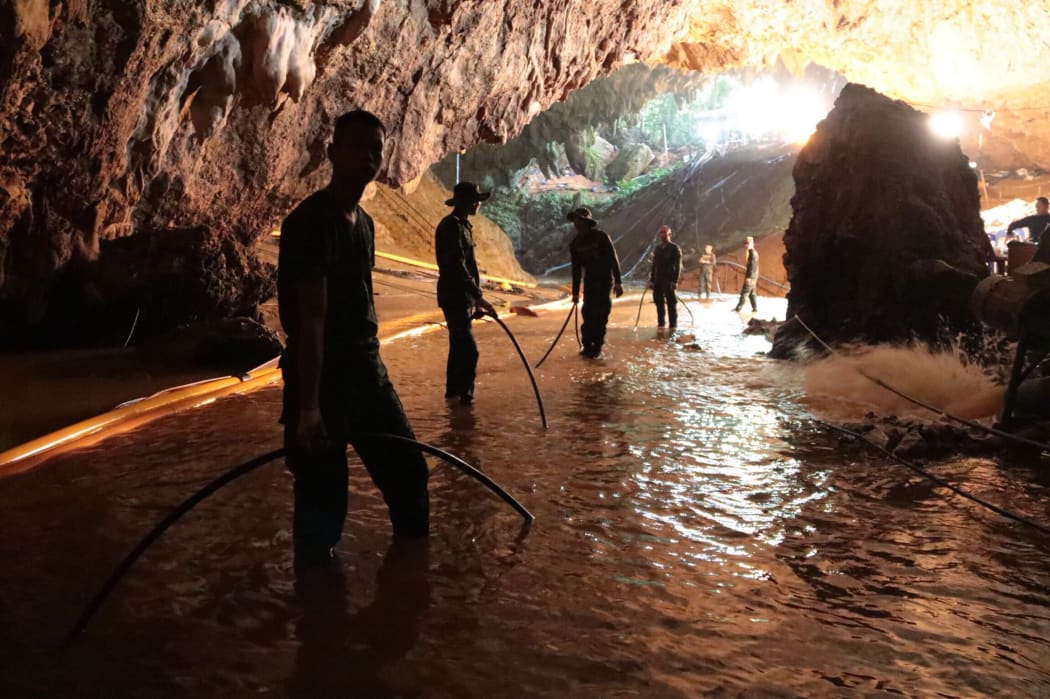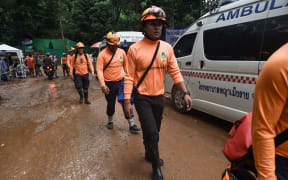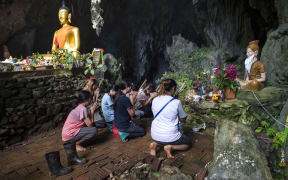A third rescue attempt is expected to be made in Thailand today to bring out the remaining four boys and their football coach trapped in the flooded Tham Luang cave.

A Royal Thai Navy image on 7 July, 2018 shows Thai Navy soldiers in the flooded Tham Luang cave during rescue operations for the 12 boys and their football team coach trapped in the cave. Photo: AFP / ROYAL THAI NAVY
The health of the four boys and their football coach is said to be good as they ready to be guided through the narrow flooded passages of the complex.
Eight boys have been brought out of the caves over the past two days.
The operation inside the Tham Luang caves has attracted global attention.
The group became trapped on 23 June after heavy rains caused flooding. They were found last week by divers.
The eight rescued boys have not been seen in public, but have been pronounced to be in reasonable health.
The four who came out on Monday were stretchered from the caves and taken to a hospital in the nearby city of Chiang Rai.
The first group of four boys, who were rescued on Sunday, are being kept in quarantine in hospital and have yet to be reunited with their parents.
The Thai authorities say the rescued boys are able to eat rice porridge, although their request for a favourite pork dish has been turned down until their digestive systems recover from 10 days without food.
A team of 90 expert divers - 40 from Thailand and 50 from overseas - has been working in the cave system.
They have been guiding the boys through darkness and submerged passageways towards the mouth of the Tham Luang cave system.
Getting to and from where the boys are has been an exhausting round trip, even for the experienced divers.
The process includes a mixture of walking, wading, climbing and diving along guide ropes already in place.
Wearing full-face masks, which are easier for novice divers than traditional respirators, each boy is being accompanied by two divers, who also carry his air supply.
The toughest part is about halfway out at a section named "T-Junction", which is so tight the divers have to take off their air tanks to get through.
Beyond that a cavern - called Chamber 3 - has been turned into a forward base for the divers.
There the boys can rest before making the last, easier walk out to the entrance. They are then taken to hospital in Chiang Rai.
In an indication of how dangerous the journey can be, a former Thai navy diver died in the caves on Friday. Saman Gunan was returning from a mission to provide the group with air tanks when he ran out of oxygen.
He lost consciousness and could not be revived. His colleagues said they would "not let the sacrifice of our friend go to waste".
The rescue mission chief said the second day of the operation had gone more smoothly than the first, taking two hours less as the procedure became more refined.
A massive pumping operation is said to have helped lower the water level inside the cave system, making the journey in and out easier than it was.
How did the group get there?
The boys were found inside the cave by British rescue divers a week ago, about 4km from the cave mouth.
Aged between 11 and 17, the team became trapped during an excursion with their coach.
It took nine days to find them in the underground network's dark depths.
The world football body Fifa has promised the boys seats at the World Cup final in Moscow, but it remains to be seen if they will be well enough to take up the offer.






